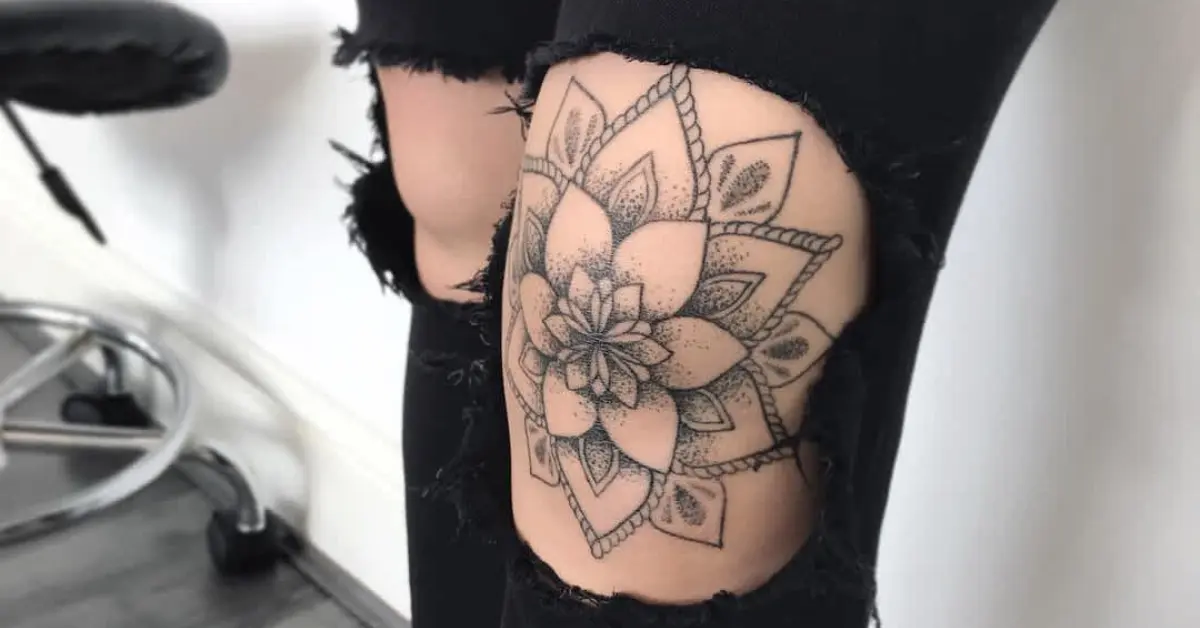Knee cap tattoos have surged in popularity, transforming the once-overlooked kneecap into a canvas for artistic expression. These tattoos defy convention, blending creativity with bravery to create captivating body art. Unlike traditional tattoos, knee cap tattoos present unique challenges due to the intricate anatomy of the knee and the discomfort associated with tattooing this area. Yet, despite the hurdles, knee cap tattoos continue to captivate enthusiasts worldwide.
In recent years, knee cap tattoos have emerged as a trendsetter in the world of body art. One reason for their popularity is their ability to stand out and make a bold statement. The kneecap’s prominence, coupled with the intricate designs that adorn it, makes knee cap tattoos visually striking and attention-grabbing. Moreover, knee cap tattoos offer individuals an opportunity for self-expression and creativity, allowing them to showcase their personality and interests through their body art.
When it comes to knee cap tattoos, choosing the right design and artist is paramount. The design should not only be aesthetically pleasing but also hold personal significance for the individual receiving the tattoo. Additionally, selecting an experienced and reputable tattoo artist ensures that the tattoo is executed with precision and care, minimizing the risk of complications and ensuring a satisfactory outcome. By prioritizing the design and artist selection process, individuals can ensure that their knee cap tattoo is not only visually stunning but also meaningful and enduring.
Understanding Knee Cap Tattoos
The knee is a complex joint comprising bones, ligaments, tendons, and cartilage, making it a challenging area for tattooing. The kneecap, or patella, is a small, flat bone that sits at the front of the knee joint, providing protection and support. However, the kneecap’s convex shape and limited surface area pose challenges for tattoo artists, requiring them to adapt their techniques to ensure optimal results.
Before getting a knee cap tattoo, several factors should be taken into account. Firstly, individuals should assess their pain tolerance levels, as tattooing the knee can be more uncomfortable compared to other body parts due to the proximity to bone and lack of flesh. Additionally, individuals should consider the long-term implications of a knee cap tattoo, such as potential fading or distortion over time, and whether they are willing to commit to the necessary aftercare regimen to ensure proper healing and preservation of the tattoo.
Pain perception and tolerance levels vary from person to person, influenced by factors such as individual pain thresholds, skin sensitivity, and psychological factors. While some individuals may find the sensation of getting a knee cap tattoo tolerable, others may experience more discomfort. To manage pain during the tattooing process, tattoo artists may employ various techniques such as applying numbing creams or using distraction methods to help alleviate discomfort and ensure a more positive experience for the client.
Popular Knee Cap Tattoo Designs
Mandala knee cap tattoos are a popular choice for those seeking intricate and visually stunning designs. Mandalas, which originated in Hindu and Buddhist traditions, are geometric patterns that symbolize unity, harmony, and the universe’s eternal cycle. When tattooed on the knee cap, mandalas create a mesmerizing focal point, drawing the viewer’s gaze and invoking a sense of wonder and spiritual connection.
For individuals fascinated by the cosmos, knee cap tattoos featuring celestial constellations are a perfect choice. These tattoos depict the arrangement of stars in the night sky, symbolizing the vastness of the universe and humanity’s place within it. Whether it’s the zodiac constellations or a custom arrangement of stars, cosmic knee cap tattoos evoke a sense of awe and wonder, inviting contemplation of the mysteries of the cosmos.
Floral knee cap tattoos celebrate the beauty and ephemeral nature of flowers, showcasing delicate petals and lush foliage in stunning detail. From intricate roses to graceful cherry blossoms, floral designs offer endless possibilities for customization and personalization. Whether the flowers hold special significance or simply evoke a sense of beauty and tranquility, floral knee cap tattoos are a timeless and elegant choice for body art enthusiasts.
Sacred geometry knee cap tattoos blend mathematical precision with spiritual symbolism, creating mesmerizing patterns that resonate with deeper meanings. These tattoos often feature geometric shapes such as circles, triangles, and hexagons, arranged in intricate patterns inspired by ancient symbols and sacred geometry principles. By adorning the knee cap with sacred geometry, individuals can imbue their body art with layers of significance and invite contemplation of the underlying order and harmony of the universe.
Knee cap tattoos featuring spiritual symbols are a powerful way to express one’s beliefs and values through body art. From ancient symbols like the Om to sacred symbols from various religious and cultural traditions, these tattoos carry deep meaning and significance. Whether used for protection, guidance, or spiritual enlightenment, knee cap tattoos featuring spiritual symbols serve as a constant reminder of the divine presence in one’s life.
Choosing the Right Design for You
When selecting a knee cap tattoo design, several factors should be taken into consideration. Firstly, individuals should think about the symbolism and meaning behind the design, ensuring that it resonates with their personal beliefs, values, and experiences. Additionally, factors such as size, placement, and aesthetic appeal should be considered to ensure that the tattoo complements the natural contours of the knee and enhances its visual impact.
The most meaningful knee cap tattoos are often those that hold personal significance for the individual receiving the tattoo. Whether it’s a symbol representing a cherished memory, a tribute to a loved one, or an expression of one’s passions and interests, the design should reflect the wearer’s unique identity and story. By choosing a design that holds personal significance, individuals can create a tattoo that not only looks visually stunning but also serves as a constant reminder of what is truly meaningful and important to them.
One of the benefits of knee cap tattoos is the opportunity for customization and artistic freedom. Unlike traditional tattoos, which may be limited by the size and shape of the body part, knee cap tattoos offer a relatively large and flat surface area for intricate designs and creative expression. Whether working with a tattoo artist to design a custom piece or choosing from a selection of pre-existing designs, individuals have the freedom to create a tattoo that is uniquely theirs and reflects their personality, style, and preferences.
Preparing for Your Knee Cap Tattoo
Finding a reputable tattoo artist is essential for a successful knee cap tattoo experience. Researching local tattoo studios and reading reviews from past clients can help individuals identify talented and experienced artists who specialize in knee cap tattoos. Additionally, scheduling consultations with potential artists allows individuals to discuss their ideas, ask questions, and assess the artist’s professionalism, communication skills, and artistic style before committing to the tattooing process.
During the consultation process, individuals have the opportunity to collaborate with the tattoo artist to create a custom design that meets their specific preferences and vision. Whether bringing in reference images, discussing ideas, or providing input on the design concept, the consultation serves as a crucial step in ensuring that both the client and the artist are aligned on the final design. Tattoo artists may offer insights and suggestions based on their expertise, helping to refine the design and optimize it for the unique contours of the knee cap. By fostering open communication and collaboration, individuals can feel confident in their choice of design and artist, setting the stage for a positive tattooing experience.
In the days leading up to the tattoo appointment, it’s essential to properly prepare the skin to ensure optimal results and minimize discomfort during the tattooing process. This includes keeping the skin well-hydrated and moisturized to promote elasticity and reduce the risk of irritation. Additionally, individuals should avoid sun exposure and tanning beds, as sunburned or damaged skin can affect the quality of the tattoo and prolong the healing process. Following the tattoo artist’s specific pre-tattoo care instructions helps to create an ideal canvas for the tattoo and sets the stage for a successful and satisfying experience.
The Tattooing Process
The tattooing process typically begins with the tattoo artist outlining the design on the knee cap using a stencil or freehand technique. Once the design is finalized, the tattooing begins, with the artist using a tattoo machine to inject ink into the skin. While some discomfort is to be expected during the tattoo session, especially on sensitive areas like the knee cap, there are various pain management techniques that can help alleviate discomfort and ensure a more positive experience for the client. These may include applying topical numbing creams, using distraction techniques such as music or conversation, and taking breaks as needed to rest and relax.
The duration of the tattooing process can vary depending on factors such as the size and complexity of the design, the client’s pain tolerance, and the tattoo artist’s speed and efficiency. Generally, knee cap tattoos may take anywhere from a few hours to several sessions spread out over multiple days to complete, depending on the intricacy of the design and the client’s preferences. Throughout the tattoo session, the artist works methodically, layering ink and shading to bring the design to life, pausing periodically to allow the client to rest and stretch as needed.
Clear communication between the client and the tattoo artist is essential throughout the tattooing process to ensure that the client’s needs and preferences are met and that the final result exceeds expectations. Clients are encouraged to communicate openly with the artist about any discomfort or concerns they may have, allowing the artist to adjust their technique or take additional measures to ensure the client’s comfort and satisfaction. Likewise, artists may provide guidance and updates on the progress of the tattoo, seeking input and feedback from the client to ensure that they are happy with the direction of the design.
Aftercare Tips for Knee Cap Tattoos
After the tattooing process is complete, it’s crucial to follow the tattoo artist’s specific aftercare instructions to promote proper healing and ensure the longevity of the tattoo. This may include keeping the tattoo clean and dry, applying a thin layer of ointment or moisturizer to keep the skin hydrated, and avoiding activities that may irritate or damage the tattooed area. Additionally, clients should refrain from picking or scratching at the tattoo as it heals, as this can disrupt the healing process and affect the outcome of the tattoo.
In the days and weeks following the tattoo appointment, clients should continue to monitor the tattooed area and follow a consistent aftercare routine to promote optimal healing. This may include gently washing the tattoo with mild soap and water, avoiding direct sunlight and tanning beds, and wearing loose-fitting clothing to prevent friction and irritation. As the tattoo heals, clients may experience some minor discomfort, redness, and swelling, which can typically be managed with over-the-counter pain relievers and by following the tattoo artist’s aftercare instructions diligently.
While knee cap tattoos can be a rewarding and visually stunning form of body art, it’s essential to be aware of potential pitfalls and complications that may arise during the healing process. These may include infection, allergic reactions, and fading or distortion of the tattoo over time. To minimize the risk of complications, clients should strictly adhere to the aftercare instructions provided by their tattoo artist, avoid exposing the tattoo to harsh chemicals or abrasive materials, and seek prompt medical attention if they experience any signs of infection or adverse reactions.
Knee Cap Tattoo Pain and Recovery
As with any tattoo, clients may experience some pain and discomfort during the healing period, particularly in sensitive areas like the kneecap. To manage pain and discomfort, clients can take over-the-counter pain relievers such as ibuprofen or acetaminophen, apply cool compresses or ice packs to reduce swelling and elevate the affected leg to promote circulation and alleviate pressure on the knee. Additionally, keeping the tattooed area clean and moisturized can help soothe irritated skin and promote faster healing.
The recovery timeline for knee cap tattoos can vary depending on factors such as the size and complexity of the design, the client’s overall health and immune response, and how well they adhere to the aftercare instructions provided by their tattoo artist. Generally, knee cap tattoos may take several weeks to fully heal, with the initial stages of healing marked by redness, swelling, and tenderness, followed by a gradual fading and settling of the tattoo over time. While most clients experience a relatively smooth recovery process, some may encounter challenges such as delayed healing, allergic reactions, or infections, which may require medical intervention and additional care.
While rare, infections can occur following a knee cap tattoo, particularly if proper aftercare protocols are not followed or if the tattooed area is exposed to bacteria or other pathogens. Signs of infection may include excessive redness, swelling, pain, and warmth around the tattooed area, as well as the presence of pus or fluid drainage. If any of these symptoms are present or if the client experiences fever, chills, or other systemic symptoms, it’s essential to seek medical attention promptly to prevent further complications and ensure proper treatment.
Showcasing Knee Cap Tattoo Inspiration
For those seeking inspiration for their own knee cap tattoo, real-life examples can provide valuable insights into different design styles, techniques, and aesthetic preferences. From intricate mandalas and cosmic constellations to vibrant floral motifs and sacred symbols, there is no shortage of creativity and artistry in the world of knee cap tattoos. By exploring photos and testimonials from individuals who have received knee cap tattoos, clients can gain a better understanding of what to expect and feel inspired to create a unique and meaningful tattoo of their own.
Testimonials from individuals who have undergone the knee cap tattooing process can offer valuable insights and firsthand experiences to those considering getting a similar tattoo. By sharing their stories, clients can provide guidance, reassurance, and advice to others embarking on their tattoo journey. Whether discussing the tattoo design process, sharing tips for pain management and aftercare, or reflecting on the emotional significance of their tattoo, testimonials can help prospective clients feel more informed and confident in their decision to pursue a knee cap tattoo.
Ultimately, knee cap tattoos are a form of creative expression and personal empowerment, allowing individuals to showcase their unique personalities, interests, and experiences through body art. By embracing creativity and self-expression, clients can create a tattoo that not only looks visually stunning but also holds deep personal meaning and significance. Whether paying homage to a loved one, expressing spiritual beliefs, or simply celebrating their individuality, knee cap tattoos offer a blank canvas for individuals to tell their stories and leave a lasting mark on their bodies.
Conclusion
Knee cap tattoos represent a bold and captivating form of body art, merging creativity with bravery to create visually stunning and meaningful designs. From intricate mandalas to celestial constellations, knee cap tattoos offer endless possibilities for self-expression and artistic exploration. By understanding the anatomy of the knee, choosing the right design and artist, and following proper aftercare protocols, individuals can ensure a positive and satisfying tattoo experience. Whether seeking inspiration, guidance, or reassurance, the world of knee cap tattoos invites individuals to embark on a journey of self-discovery, creativity, and personal empowerment.



